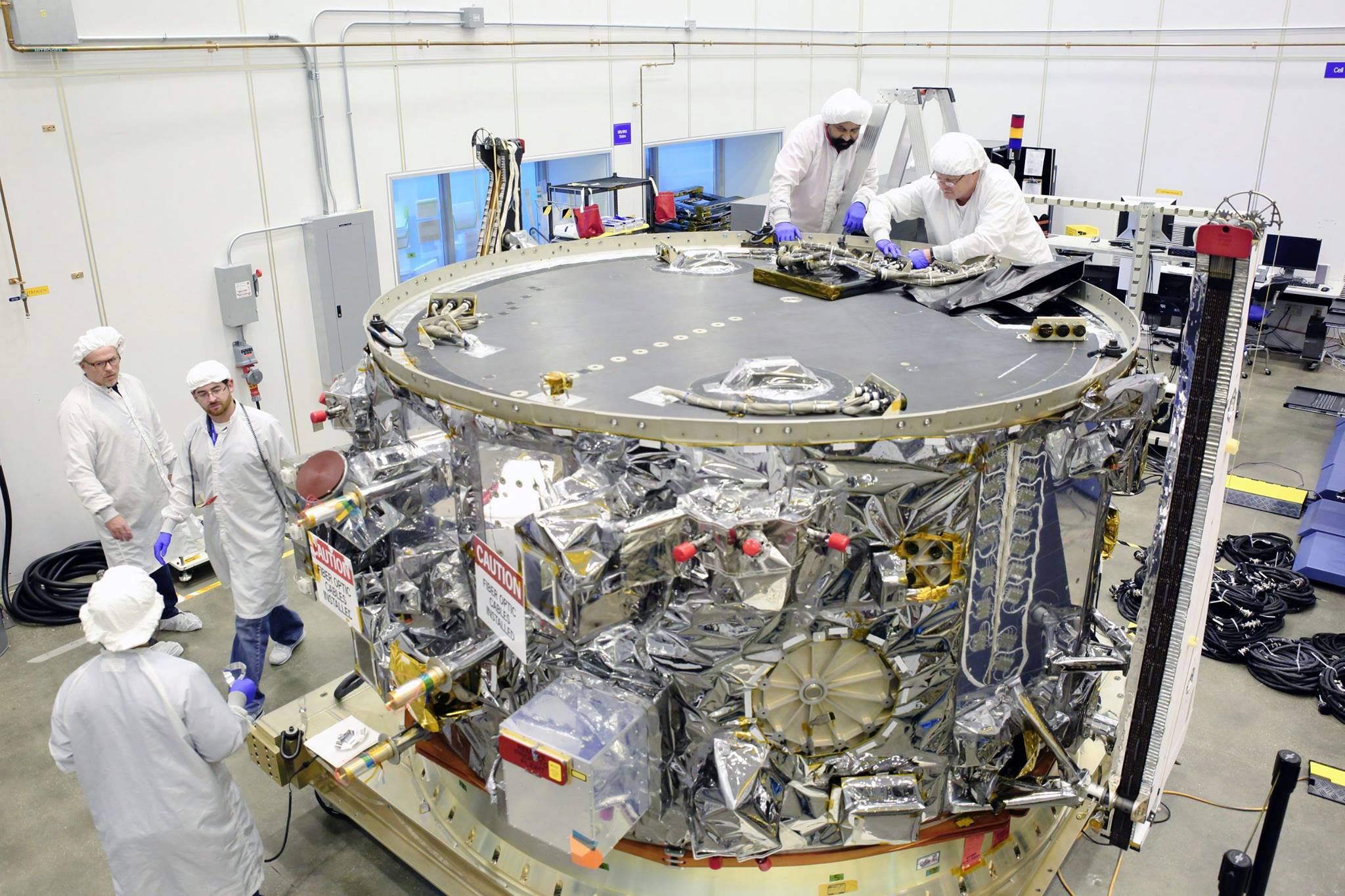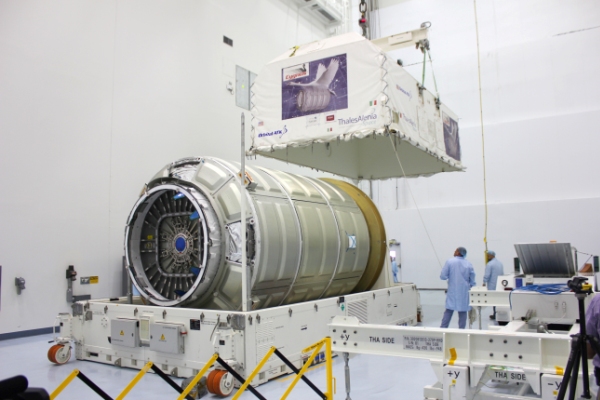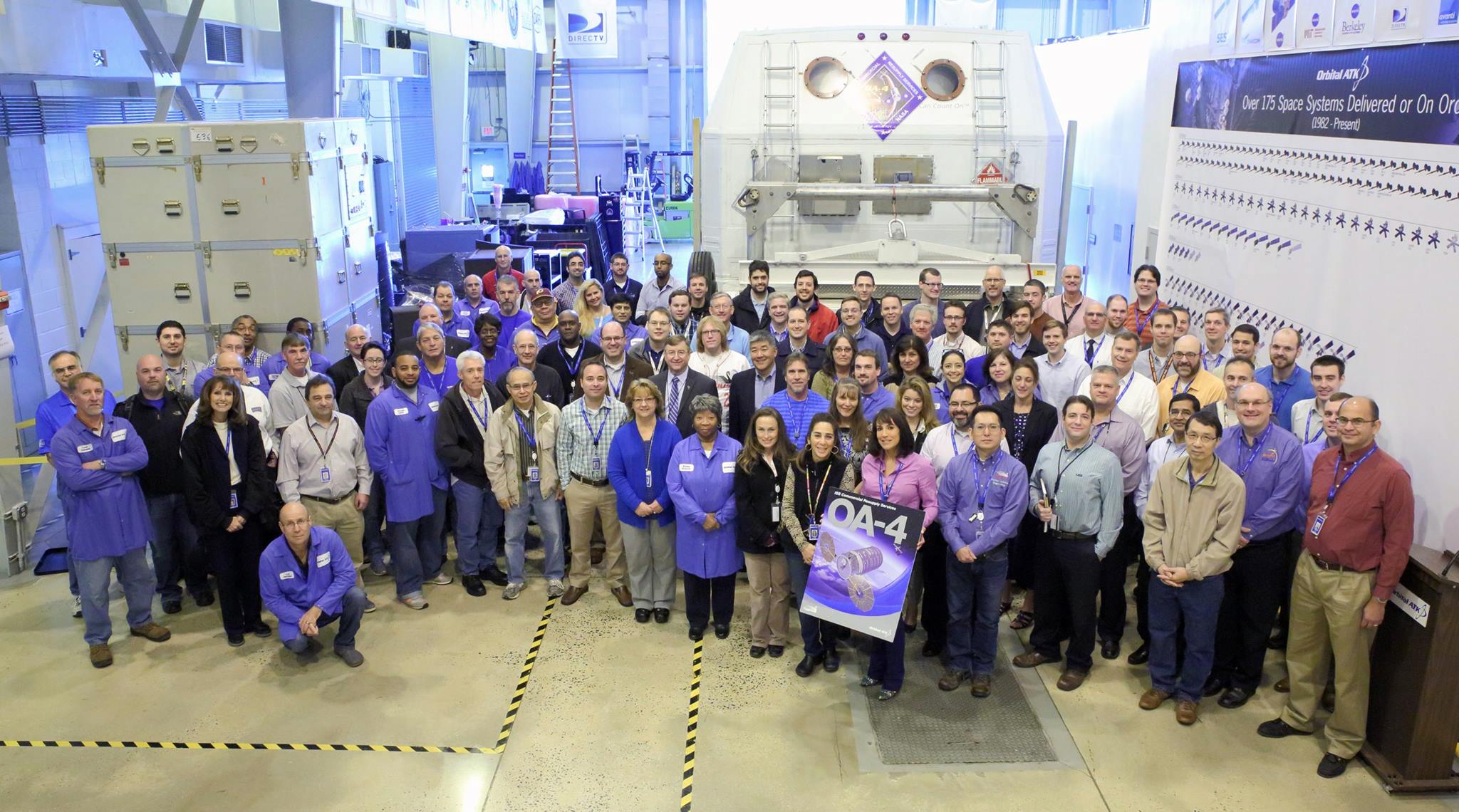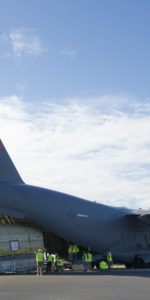From Orbital ATK: ” … We shipped the service module for our Cygnus spacecraft to NASA’s Kennedy Space Center for our next ISS cargo resupply mission, scheduled to launch in early December. Today’s OA-4 milestone marks a key step forward as we continue cargo delivery service to the ISS under the Commercial Resupply Services contract.” Photo Credit: Orbital ATK Nearly one year following a spectacular launch failure at NASA’s Wallops Flight Facility that lit up Virginia’s evening skies (and the evening news), Orbital ATK is gearing up for the planned Dec. 3 launch of an enhanced unmanned Cygnus cargo spacecraft, which will be mated to an Atlas V launch vehicle at Cape Canaveral Air Force Station’s (CCAFS) Launch Complex 41.
Orbital ATK announced Tuesday, Oct. 12, that it delivered the cargo ship’s service module to NASA’s Kennedy Space Center (KSC) in Florida, soon to be integrated with the ship’s pressurized cargo module (PCM). The company stated that the service module contains Cygnus’ avionics, electrical, propulsion, and communications systems, while the PCM contains the spacecraft’s cargo volume. The OA-4 mission will mark the first of two planned launches utilizing United Launch Alliance’s Atlas V launch vehicle mated with a Cygnus spacecraft, and the first mission of the enhanced cargo ship, which will be able to carry 7,700 pounds of supplies, experiments, and equipment to the International Space Station (ISS).
Cygnus’ Pressurized Cargo Module (PCM) arrives at KSC ahead if the OA-4 mission. Photo Credit: Orbital ATK Orbital ATK added in their announcement that the final assembly, cargo loading, and fueling of Cygnus will also take place at KSC. Besides being the first “enhanced” variant of Cygnus, the spacecraft will also boast UltraFlex solar arrays, described as “the latest in lightweight space-qualified power system technology”; these arrays were developed by the company’s Space Components Division.
Cygnus’ “return to flight” comes after a very public catastrophic failure. On Oct. 28, 2014, Orb 3, Cygnus’ third commercial resupply flight, came to an abrupt, fiery end as the mission’s Antares 130 launch vehicle fell back Deke Slayton (after the late Mercury 7/Apollo-Soyuz astronaut), was destroyed in a massive conflagration; the launch pad and adjacent areas sustained $15 million in damages. This kicked off a difficult year in cargo deliveries to the ISS, as a Russian Progress cargo ship and a SpaceX Dragon cargo capsule
While a previous AmericaSpace article discussed theories concerning possible causes of the failure another enhanced Cygnus will be delivered to the ISS in early spring 2016, utilizing an Atlas V
In addition, repairs to MARS Launch Pad 01 were recently wrapped up. The Virginia Commercial Space Flight Authority announced weeks ago that repairs were completed by a Sept. 30 deadline, with NASA, Orbital ATK, and Virginia Space splitting the cost three ways, contributing $5 million each. An AmericaSpace article
“Over the last few months, 90 [to] 100 MARS employees and contractors worked round the clock to restore Launch Pad 0A to a flight-ready condition. Work began with remediation around the impact site, where the 20-foot-wide, 10-foot-deep crater was filled and contaminants were removed from the topsoil. Damaged structures were repaired and replaced, including liquid propellant feed lines which supply liquid oxygen and kerosene to the rocket and portions of the sound suppression water deluge system, which flood the pad with water to protect it from the energy released at liftoff. New lightning protection towers were installed, two of which were demolished in the explosion. An upgraded hydraulic system was installed, which will be capable of erecting the new Antares in its heavier 230 configuration. Electrical systems, heating and cooling systems, and the pad’s fire alarm were also repaired.” The article underscored that the most critical structures of the pad were fortunately (and incredibly) spared in the rocket’s fall back, and ensuing fire.
Orbital ATK employees celebrate the delivery of OA-4’s prime components to KSC. Photo Credit: Orbital ATK While the launch pad has “healed” from the accident and Antares receives an upgrade, Orbital ATK was pressed into making commercial resupply flights a reality, even without a flagship launch vehicle. The Cygnus spacecraft was designed to be adaptable with multiple launch vehicles, allowing for flexibility; Orbital ATK emphasized, “This capability supports NASA’s requirements for additional cargo and also provides better schedule assurance for future missions.”
Frank Culbertson, president of the company’s Space Systems Group and former space shuttle/ISS astronaut, emphasized the program’s adaptability despite adversity. “With OA-4 set to launch in December and at least three additional missions to the Space Station planned in 2016, we remain solidly on schedule to meet our CRS cargo requirements for NASA. Our team’s performance in meeting milestones on an accelerated time line demonstrates the company’s flexibility and responsiveness to customer needs,” he declared. If all goes as planned, on Dec. 3, space watchers new and seasoned can thrill to seeing a unique, “two-of-its-kind” launch, as an Atlas V launcher lofts a Cygnus cargo ship to orbit.
Be sure to “Like” AmericaSpace on Facebook and follow us on Twitter: @AmericaSpace
Missions »
ISS »
COTS »
CYGNUS »
Posts associated with the ISS missions After Daylong Delay, NG-20 Cygnus Launches, Heads to Space Station
After Four-Month-Plus Stay, NG-19 Cygnus Cargo Ship Leaves Space Station
Last Antares 200-Series Rocket Launches, Delivers NG-19 Cygnus to Space Station
Northrop Grumman Prepares for Final Antares 230 Launch Tomorrow
Northrop Grumman Launches NG-18 Cygnus to Space Station, Honors Pioneer Sally Ride
NG-17 Cygnus Departs Space Station, Wraps Up Four-Month Stay
CRS-24 Dragon Launches, Heads to Space Station
NG-16 Cygnus Departs Space Station, Heads for Re-entry
NG-16 Cygnus Launches, Honors Challenger Veteran, Heads to Space Station
NG-16 Cygnus Prepares for Tuesday Launch, as OFT-2 Starliner Delay Lengthens
Next Cygnus Cargo Ship Named for Challenger Hero Ellison Onizuka
Station Crew Readies for Tuesday Cygnus Departure, NG-16 Launch NET 10 August
As CRS-22 Readies for Thursday Launch, SpaceX, AxiomSpace Plan for Four Missions Through 2023
SpaceX, ULA Primed for Five Launches in June, CRS-22 Dragon Set to Fly Thursday
Crew-2 Launches, Takes Aim on Space Station for Saturday Arrival
SpaceX Static-Fires Falcon 9 for Crew-2, As Boeing OFT-2 Mission Aims for Aug-Sept Launch
Crew-2 Astronauts Discuss Upcoming Mission, Eye 20 April Launch to ISS
Northrop Grumman Green-Lights Two More Cygnus Missions, As NG-15 Arrives at Space Station
ISS-Bound NG-15 Cygnus Honors ‘Hidden Figure’ Katherine Johnson
Multi-National Crew-2 Gears Up for 20 April Launch to Space Station
NG-14 Cygnus Departs Space Station, Two Weeks of Autonomous Fire Safety, Tech Experiments Ahead
NG-14 Cygnus Arrives at Space Station, Ahead of Expedition 64 Launch Next Week
Antares Breaks Launch Week Curse, as SpaceX Suffers Last-Second Scrub
Scrub Week Continues, Antares Launch Now NET Friday Night
Next NASA, SpaceX Crew Launch Set for Oct 31 with ‘Crew-1’
NG-14 Cygnus Readies for Tuesday Night Launch From Wallops
Next Cygnus Cargo Ship Named for Columbia Astronaut Kalpana Chawla
Second-Heaviest Cygnus, Antares Booster Processing Ramps Up for NG-14 Mission
Next Cygnus Supply Mission Targets 29 Sept Launch to Space Station
Rubins, Crewmates Discuss Upcoming Space Station Mission
Demo-2 Docks at Space Station, Expedition 63 Expands to Five Crew
T-1 Day: NASA, SpaceX Ready to Bring Human Spaceflight Back to America (Part 2)
NASA, SpaceX Ready to Return Human Spaceflight to American Soil (Part 1)
Astronauts Arrive in Florida for Launch Next Week on SpaceX Demo-2 Mission
Starlink Mission Slips to NET June; Demo-2 Next Up for SpaceX
Cygnus Departs Space Station; 2 Weeks of SAFFIRE Experiments Planned
NASA, SpaceX Preview First Crewed Dragon Mission, Set for May 27 Launch
NG-13 Cygnus Begins ISS Chase with 8,000 Pounds of Cargo for Space Station
Antares to Launch NG-13 ISS Resupply Tonight from VA, Spacecraft Named After Robert Lawrence
SpaceX Crew Dragon Inflight Abort Test Video
Antares Ready for Saturday Launch from Virginia to Resupply ISS (NG-12)
Antares to Launch NG-11 Cygnus from VA April 17, Honors Apollo 1 Hero Roger Chaffee
Crew Dragon Kicks Off Demo-1 Mission to Return Human Spaceflight to American Shores
Decade-Long Crew Dragon Program Stands Ready for Maiden Mission (Part 2)
Decade-Long Crew Dragon Program Stands Ready for Maiden Mission (Part 1)
NASA Clears SpaceX to Launch Crew Dragon ‘Demo-1’ on March 2
First Crew Dragon Demo On Track for Late-Night Launch March 2
Good Test Fire for First Crew Dragon Mission Paves Way to Launch NET Late February
Cygnus Arrives at Space Station with 7,400 Pounds of Fresh Supplies and Science
Antares Launches Ninth Cygnus Cargo Delivery Mission to Space Station
Posts associated with the COTS missions After Daylong Delay, NG-20 Cygnus Launches, Heads to Space Station
After Four-Month-Plus Stay, NG-19 Cygnus Cargo Ship Leaves Space Station
Last Antares 200-Series Rocket Launches, Delivers NG-19 Cygnus to Space Station
Northrop Grumman Prepares for Final Antares 230 Launch Tomorrow
Northrop Grumman Launches NG-18 Cygnus to Space Station, Honors Pioneer Sally Ride
NG-17 Cygnus Departs Space Station, Wraps Up Four-Month Stay
CRS-24 Dragon Launches, Heads to Space Station
NG-16 Cygnus Departs Space Station, Heads for Re-entry
NG-16 Cygnus Launches, Honors Challenger Veteran, Heads to Space Station
NG-16 Cygnus Prepares for Tuesday Launch, as OFT-2 Starliner Delay Lengthens
Next Cygnus Cargo Ship Named for Challenger Hero Ellison Onizuka
Station Crew Readies for Tuesday Cygnus Departure, NG-16 Launch NET 10 August
As CRS-22 Readies for Thursday Launch, SpaceX, AxiomSpace Plan for Four Missions Through 2023
SpaceX, ULA Primed for Five Launches in June, CRS-22 Dragon Set to Fly Thursday
Northrop Grumman Green-Lights Two More Cygnus Missions, As NG-15 Arrives at Space Station
ISS-Bound NG-15 Cygnus Honors ‘Hidden Figure’ Katherine Johnson
NG-14 Cygnus Departs Space Station, Two Weeks of Autonomous Fire Safety, Tech Experiments Ahead
NG-14 Cygnus Arrives at Space Station, Ahead of Expedition 64 Launch Next Week
Antares Breaks Launch Week Curse, as SpaceX Suffers Last-Second Scrub
Scrub Week Continues, Antares Launch Now NET Friday Night
NG-14 Cygnus Readies for Tuesday Night Launch From Wallops
Next Cygnus Cargo Ship Named for Columbia Astronaut Kalpana Chawla
Second-Heaviest Cygnus, Antares Booster Processing Ramps Up for NG-14 Mission
Next Cygnus Supply Mission Targets 29 Sept Launch to Space Station
Cygnus Departs Space Station; 2 Weeks of SAFFIRE Experiments Planned
NG-13 Cygnus Begins ISS Chase with 8,000 Pounds of Cargo for Space Station
Antares to Launch NG-13 ISS Resupply Tonight from VA, Spacecraft Named After Robert Lawrence
Antares Ready for Saturday Launch from Virginia to Resupply ISS (NG-12)
Antares to Launch NG-11 Cygnus from VA April 17, Honors Apollo 1 Hero Roger Chaffee
Cygnus Arrives at Space Station with 7,400 Pounds of Fresh Supplies and Science
Antares Launches Ninth Cygnus Cargo Delivery Mission to Space Station
SpaceX Launches Fourth Dragon of 2017, Nails 20th Landing with CRS-13 Mission
SLC-40 Ready for Return to Flight, With Fourth ISS-Bound Dragon of 2017
SpaceX Says New Improved SLC-40 Ready for Launches Again Following CRS-13 Test Fire
Orbital ATK Honors Veterans With Rousing Launch of OA-8 Cygnus to Space Station
SpaceX Launches Third Dragon of 2017 to Space Station, Lands 6th Rocket on LZ-1
Storms Threaten Post-Landing Securing of Falcon 9 First Stage on Monday
UPDATE: Good Falcon 9 Test Fire as SpaceX Aims for Aug 14 CRS-12 Launch
PHOTOS: SpaceX CRS-11 Launch and Landing
First Reusable Dragon Cargo Mission Launches Science and Supplies to Space Station
‘Godspeed, John Glenn’: Cygnus Soars Atop Atlas-V on Voyage to Space Station
John Glenn to Return to Space ‘In Spirit’ on ISS-Bound OA-7 Cygnus Cargo Mission
NASA Outlines Science Payloads, Ahead of Next ISS-Bound Cygnus Cargo Mission
SpaceX Soars from 39A for First Time, Delivers Dragon to Space & Returns Falcon to Earth
Pad 39A Set for First Post-Shuttle Launch, as SpaceX Readies for Weekend Return to Space Station
NASA Outlines Science Heading to Space Station Aboard CRS-10 Dragon
Through the Lens: Antares Returns to Flight on OA-5 Mission for NASA
Antares Returns to Flight, Delivering OA-5 Cygnus to Space Station
SpaceX Nails Launch and Landing Again, Dragon CRS-9 Now En Route to Space Station
Critical Science, Commercial Crew Hardware Headed to Space Station Aboard CRS-9 Dragon
Missions »
ISS »
COTS »
CYGNUS »
ORB-4 »
Posts associated with the ISS missions After Daylong Delay, NG-20 Cygnus Launches, Heads to Space Station
After Four-Month-Plus Stay, NG-19 Cygnus Cargo Ship Leaves Space Station
Last Antares 200-Series Rocket Launches, Delivers NG-19 Cygnus to Space Station
Northrop Grumman Prepares for Final Antares 230 Launch Tomorrow
Northrop Grumman Launches NG-18 Cygnus to Space Station, Honors Pioneer Sally Ride
NG-17 Cygnus Departs Space Station, Wraps Up Four-Month Stay
CRS-24 Dragon Launches, Heads to Space Station
NG-16 Cygnus Departs Space Station, Heads for Re-entry
NG-16 Cygnus Launches, Honors Challenger Veteran, Heads to Space Station
NG-16 Cygnus Prepares for Tuesday Launch, as OFT-2 Starliner Delay Lengthens
Next Cygnus Cargo Ship Named for Challenger Hero Ellison Onizuka
Station Crew Readies for Tuesday Cygnus Departure, NG-16 Launch NET 10 August
As CRS-22 Readies for Thursday Launch, SpaceX, AxiomSpace Plan for Four Missions Through 2023
SpaceX, ULA Primed for Five Launches in June, CRS-22 Dragon Set to Fly Thursday
Crew-2 Launches, Takes Aim on Space Station for Saturday Arrival
SpaceX Static-Fires Falcon 9 for Crew-2, As Boeing OFT-2 Mission Aims for Aug-Sept Launch
Crew-2 Astronauts Discuss Upcoming Mission, Eye 20 April Launch to ISS
Northrop Grumman Green-Lights Two More Cygnus Missions, As NG-15 Arrives at Space Station
ISS-Bound NG-15 Cygnus Honors ‘Hidden Figure’ Katherine Johnson
Multi-National Crew-2 Gears Up for 20 April Launch to Space Station
NG-14 Cygnus Departs Space Station, Two Weeks of Autonomous Fire Safety, Tech Experiments Ahead
NG-14 Cygnus Arrives at Space Station, Ahead of Expedition 64 Launch Next Week
Antares Breaks Launch Week Curse, as SpaceX Suffers Last-Second Scrub
Scrub Week Continues, Antares Launch Now NET Friday Night
Next NASA, SpaceX Crew Launch Set for Oct 31 with ‘Crew-1’
NG-14 Cygnus Readies for Tuesday Night Launch From Wallops
Next Cygnus Cargo Ship Named for Columbia Astronaut Kalpana Chawla
Second-Heaviest Cygnus, Antares Booster Processing Ramps Up for NG-14 Mission
Next Cygnus Supply Mission Targets 29 Sept Launch to Space Station
Rubins, Crewmates Discuss Upcoming Space Station Mission
Demo-2 Docks at Space Station, Expedition 63 Expands to Five Crew
T-1 Day: NASA, SpaceX Ready to Bring Human Spaceflight Back to America (Part 2)
NASA, SpaceX Ready to Return Human Spaceflight to American Soil (Part 1)
Astronauts Arrive in Florida for Launch Next Week on SpaceX Demo-2 Mission
Starlink Mission Slips to NET June; Demo-2 Next Up for SpaceX
Cygnus Departs Space Station; 2 Weeks of SAFFIRE Experiments Planned
NASA, SpaceX Preview First Crewed Dragon Mission, Set for May 27 Launch
NG-13 Cygnus Begins ISS Chase with 8,000 Pounds of Cargo for Space Station
Antares to Launch NG-13 ISS Resupply Tonight from VA, Spacecraft Named After Robert Lawrence
SpaceX Crew Dragon Inflight Abort Test Video
Antares Ready for Saturday Launch from Virginia to Resupply ISS (NG-12)
Antares to Launch NG-11 Cygnus from VA April 17, Honors Apollo 1 Hero Roger Chaffee
Crew Dragon Kicks Off Demo-1 Mission to Return Human Spaceflight to American Shores
Decade-Long Crew Dragon Program Stands Ready for Maiden Mission (Part 2)
Decade-Long Crew Dragon Program Stands Ready for Maiden Mission (Part 1)
NASA Clears SpaceX to Launch Crew Dragon ‘Demo-1’ on March 2
First Crew Dragon Demo On Track for Late-Night Launch March 2
Good Test Fire for First Crew Dragon Mission Paves Way to Launch NET Late February
Cygnus Arrives at Space Station with 7,400 Pounds of Fresh Supplies and Science
Antares Launches Ninth Cygnus Cargo Delivery Mission to Space Station
Posts associated with the COTS missions After Daylong Delay, NG-20 Cygnus Launches, Heads to Space Station
After Four-Month-Plus Stay, NG-19 Cygnus Cargo Ship Leaves Space Station
Last Antares 200-Series Rocket Launches, Delivers NG-19 Cygnus to Space Station
Northrop Grumman Prepares for Final Antares 230 Launch Tomorrow
Northrop Grumman Launches NG-18 Cygnus to Space Station, Honors Pioneer Sally Ride
NG-17 Cygnus Departs Space Station, Wraps Up Four-Month Stay
CRS-24 Dragon Launches, Heads to Space Station
NG-16 Cygnus Departs Space Station, Heads for Re-entry
NG-16 Cygnus Launches, Honors Challenger Veteran, Heads to Space Station
NG-16 Cygnus Prepares for Tuesday Launch, as OFT-2 Starliner Delay Lengthens
Next Cygnus Cargo Ship Named for Challenger Hero Ellison Onizuka
Station Crew Readies for Tuesday Cygnus Departure, NG-16 Launch NET 10 August
As CRS-22 Readies for Thursday Launch, SpaceX, AxiomSpace Plan for Four Missions Through 2023
SpaceX, ULA Primed for Five Launches in June, CRS-22 Dragon Set to Fly Thursday
Northrop Grumman Green-Lights Two More Cygnus Missions, As NG-15 Arrives at Space Station
ISS-Bound NG-15 Cygnus Honors ‘Hidden Figure’ Katherine Johnson
NG-14 Cygnus Departs Space Station, Two Weeks of Autonomous Fire Safety, Tech Experiments Ahead
NG-14 Cygnus Arrives at Space Station, Ahead of Expedition 64 Launch Next Week
Antares Breaks Launch Week Curse, as SpaceX Suffers Last-Second Scrub
Scrub Week Continues, Antares Launch Now NET Friday Night
NG-14 Cygnus Readies for Tuesday Night Launch From Wallops
Next Cygnus Cargo Ship Named for Columbia Astronaut Kalpana Chawla
Second-Heaviest Cygnus, Antares Booster Processing Ramps Up for NG-14 Mission
Next Cygnus Supply Mission Targets 29 Sept Launch to Space Station
Cygnus Departs Space Station; 2 Weeks of SAFFIRE Experiments Planned
NG-13 Cygnus Begins ISS Chase with 8,000 Pounds of Cargo for Space Station
Antares to Launch NG-13 ISS Resupply Tonight from VA, Spacecraft Named After Robert Lawrence
Antares Ready for Saturday Launch from Virginia to Resupply ISS (NG-12)
Antares to Launch NG-11 Cygnus from VA April 17, Honors Apollo 1 Hero Roger Chaffee
Cygnus Arrives at Space Station with 7,400 Pounds of Fresh Supplies and Science
Antares Launches Ninth Cygnus Cargo Delivery Mission to Space Station
SpaceX Launches Fourth Dragon of 2017, Nails 20th Landing with CRS-13 Mission
SLC-40 Ready for Return to Flight, With Fourth ISS-Bound Dragon of 2017
SpaceX Says New Improved SLC-40 Ready for Launches Again Following CRS-13 Test Fire
Orbital ATK Honors Veterans With Rousing Launch of OA-8 Cygnus to Space Station
SpaceX Launches Third Dragon of 2017 to Space Station, Lands 6th Rocket on LZ-1
Storms Threaten Post-Landing Securing of Falcon 9 First Stage on Monday
UPDATE: Good Falcon 9 Test Fire as SpaceX Aims for Aug 14 CRS-12 Launch
PHOTOS: SpaceX CRS-11 Launch and Landing
First Reusable Dragon Cargo Mission Launches Science and Supplies to Space Station
‘Godspeed, John Glenn’: Cygnus Soars Atop Atlas-V on Voyage to Space Station
John Glenn to Return to Space ‘In Spirit’ on ISS-Bound OA-7 Cygnus Cargo Mission
NASA Outlines Science Payloads, Ahead of Next ISS-Bound Cygnus Cargo Mission
SpaceX Soars from 39A for First Time, Delivers Dragon to Space & Returns Falcon to Earth
Pad 39A Set for First Post-Shuttle Launch, as SpaceX Readies for Weekend Return to Space Station
NASA Outlines Science Heading to Space Station Aboard CRS-10 Dragon
Through the Lens: Antares Returns to Flight on OA-5 Mission for NASA
Antares Returns to Flight, Delivering OA-5 Cygnus to Space Station
SpaceX Nails Launch and Landing Again, Dragon CRS-9 Now En Route to Space Station
Critical Science, Commercial Crew Hardware Headed to Space Station Aboard CRS-9 Dragon
Posts associated with the CYGNUS missions After Daylong Delay, NG-20 Cygnus Launches, Heads to Space Station
After Four-Month-Plus Stay, NG-19 Cygnus Cargo Ship Leaves Space Station
Last Antares 200-Series Rocket Launches, Delivers NG-19 Cygnus to Space Station
Northrop Grumman Prepares for Final Antares 230 Launch Tomorrow
Northrop Grumman Launches NG-18 Cygnus to Space Station, Honors Pioneer Sally Ride
NG-17 Cygnus Departs Space Station, Wraps Up Four-Month Stay
NG-16 Cygnus Departs Space Station, Heads for Re-entry
NG-16 Cygnus Launches, Honors Challenger Veteran, Heads to Space Station
NG-16 Cygnus Prepares for Tuesday Launch, as OFT-2 Starliner Delay Lengthens
Next Cygnus Cargo Ship Named for Challenger Hero Ellison Onizuka
Station Crew Readies for Tuesday Cygnus Departure, NG-16 Launch NET 10 August
Northrop Grumman Green-Lights Two More Cygnus Missions, As NG-15 Arrives at Space Station
ISS-Bound NG-15 Cygnus Honors ‘Hidden Figure’ Katherine Johnson
NG-14 Cygnus Departs Space Station, Two Weeks of Autonomous Fire Safety, Tech Experiments Ahead
NG-14 Cygnus Arrives at Space Station, Ahead of Expedition 64 Launch Next Week
Antares Breaks Launch Week Curse, as SpaceX Suffers Last-Second Scrub
Scrub Week Continues, Antares Launch Now NET Friday Night
NG-14 Cygnus Readies for Tuesday Night Launch From Wallops
Next Cygnus Cargo Ship Named for Columbia Astronaut Kalpana Chawla
Second-Heaviest Cygnus, Antares Booster Processing Ramps Up for NG-14 Mission
Next Cygnus Supply Mission Targets 29 Sept Launch to Space Station
Cygnus Departs Space Station; 2 Weeks of SAFFIRE Experiments Planned
NG-13 Cygnus Begins ISS Chase with 8,000 Pounds of Cargo for Space Station
Antares to Launch NG-13 ISS Resupply Tonight from VA, Spacecraft Named After Robert Lawrence
Antares Ready for Saturday Launch from Virginia to Resupply ISS (NG-12)
Antares to Launch NG-11 Cygnus from VA April 17, Honors Apollo 1 Hero Roger Chaffee
Cygnus Arrives at Space Station with 7,400 Pounds of Fresh Supplies and Science
Antares Launches Ninth Cygnus Cargo Delivery Mission to Space Station
Orbital ATK Honors Veterans With Rousing Launch of OA-8 Cygnus to Space Station
‘Godspeed, John Glenn’: Cygnus Soars Atop Atlas-V on Voyage to Space Station
John Glenn to Return to Space ‘In Spirit’ on ISS-Bound OA-7 Cygnus Cargo Mission
NASA Outlines Science Payloads, Ahead of Next ISS-Bound Cygnus Cargo Mission
Through the Lens: Antares Returns to Flight on OA-5 Mission for NASA
Antares Returns to Flight, Delivering OA-5 Cygnus to Space Station
New Improved Antares Preparing for Test Fire Ahead of July 6 Return to Flight
A Look at the Science and Experiments Aboard Cygnus ‘Rick Husband’
A Cygnus Came A’Calling: Orbital ATK’s OA-6 Cargo Ship Arrives at Space Station
Spectacular Atlas V Launch Carries Rick Husband Back to Space
ULA Stands Ready to Deliver Second Orbital ATK Cygnus to Space Station on Tuesday Night
Columbia’s Final Commander Honored in Upcoming Cygnus Resupply Mission to ISS
Next Cygnus Cargo Ship ‘SS Rick Husband’ Ready for March 22 Night Launch to Space Station
Kelly and Kornienko’s Year-Long Mission Paves Way for Journey to Mars
One-Year Crew Prepares to Depart Space Station for Return to Earth
As OA-4 Cygnus Departs, Commercial Cargo Providers Prepare for Busy Visiting Vehicle Manifest
Kopra and Peake Primed for Friday Spacewalk
EVA Ahead for ISS Crew on 15 Jan, as Space Station Prepares for Ambitious 2016
Orbital ATK Shows Off Repaired Launch Pad and Antares Rocket Hardware for Return to Flight
‘What an Honor’: Space Station Crew Prepares for Friday Return to Earth
OA-4 Cygnus Cargo Ship Arrives at Space Station, Ahead of Soyuz TMA-17M Crew Departure
A Look at the Science and Experiments Flying Aboard Cygnus ‘Deke Slayton II’ to ISS
Like this: Like Loading...







